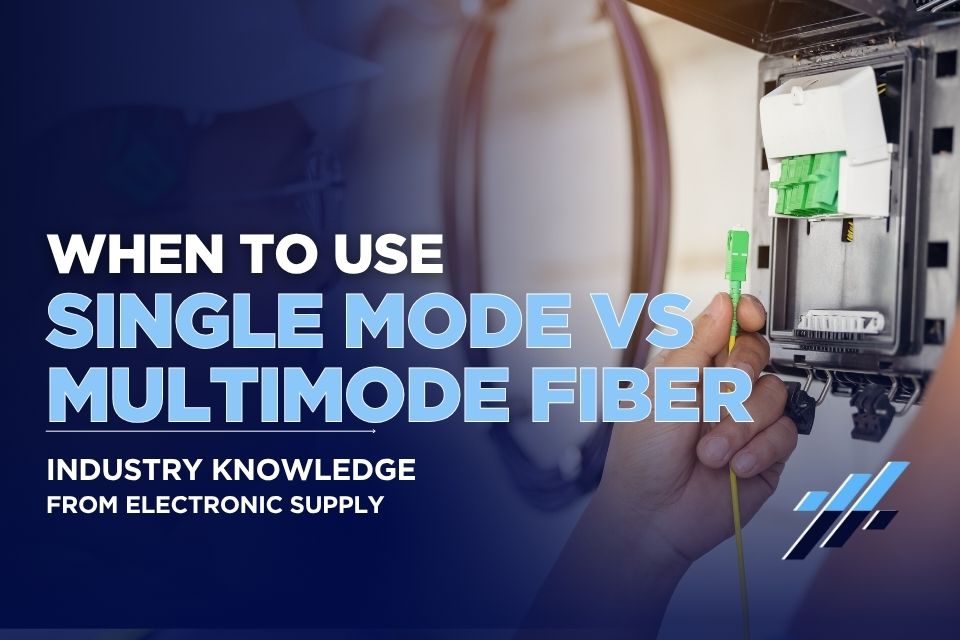Selecting the right type of fiber optic cable is a major challenge for contractors, integrators, and IT professionals. Whether you’re building a new network or upgrading an existing one, understanding the trade-offs between single mode and multimode fiber can directly impact performance, cost, and scalability. With countless specifications and compatibility concerns to juggle, it’s easy to feel overwhelmed. At Electronic Supply, we’ve been guiding professionals through these decisions since 1952. This article breaks down the distinctions and practical uses of each fiber type to help you make the right call for your next project.
Understanding Fiber Optics
What is Fiber Optics?
Fiber optics is a method of transmitting data as light pulses through flexible glass or plastic fibers. These fibers carry information at high speeds over long distances, making them essential for modern communication networks.
Overview of Light Transmission in Fiber Cables
Fiber optic cables use light to transmit data, minimizing loss and interference. A core surrounded by cladding ensures light travels in specific paths, or modes, through the cable.
Importance of Fiber Optics in Modern Networking
Fiber optics provides the backbone for internet, telecommunications, and enterprise networking. Its high bandwidth and low latency make it ideal for growing data demands, particularly in data centers and enterprise-scale applications.
Types of Fiber Optics
Introduction to Single Mode and Multimode Fiber
There are two main types of fiber optic cables: single mode and multimode. Each has unique characteristics that suit different applications.
Key Differences in Structure and Design
Single mode fiber has a small core diameter (typically 9 microns) that allows only one mode of light to propagate. This design minimizes signal loss and enables long-distance data transmission. In contrast, multimode fiber features a larger core (50 or 62.5 microns), which supports multiple light modes and is typically used for shorter-range communication.
Overview of Core Size and Light Propagation
Single mode fibers use a laser or laser diode for light transmission, enabling them to carry data over many kilometers with minimal distortion. Multimode fibers use LEDs or VCSELs. These light sources are cost-effective and suitable for shorter distances but can introduce more dispersion.
Characteristics of Single Mode Fiber
Advantages of Single Mode Fiber
Single mode fiber offers superior bandwidth capabilities, making it ideal for demanding applications that require high-speed data transfer. Its smaller core reduces modal dispersion, allowing signals to travel longer distances without degradation. Additionally, signal attenuation is significantly lower, ensuring consistent performance over extended lengths. The bandwidth single mode fiber provides is unmatched in long-distance networking.
Ideal Applications for Single Mode Fiber
This type of fiber is commonly used in long-distance telecommunications, such as service provider backbone networks and intercontinental links. It’s also prevalent in data centers and enterprise networks that require high-speed, high-reliability connectivity across large campuses. Single mode is also the preferred choice for delivering ultra-fast internet to end users in suburban and rural areas. When you need to transmit data across great distances with minimal latency, singlemode fiber is the solution.
Characteristics of Multimode Fiber
Advantages of Multimode Fiber
Multimode fiber is typically more budget-friendly because its transceivers and components cost less. It is also easier to install and terminate due to its wider core, making it a popular choice for field installers. While it supports lower bandwidth compared to single mode, it is highly effective for short distances and remains widely used in many common scenarios. For projects that require flexibility and reduced labor time, multimode fiber optic cables provide a solid return on investment.
Ideal Applications for Multimode Fiber
Multimode fiber excels in local area networks (LANs), especially within buildings like offices, schools, and hospitals. It is also well-suited for video surveillance systems where video feeds need to be transmitted over modest distances. For building-to-building connections within a single campus or business park, multimode fiber provides a cost-effective, high-performance solution. Additionally, multimode fiber optic cables are favored in audio-visual installations and other applications where ease of use and low light loss are beneficial.
Key Considerations for Choosing Between Single Mode and Multimode Fiber
Factors Influencing Your Decision
Your decision should start with distance requirements. If your installation requires signal transmission over several kilometers, single mode is the clear choice. For short runs under two kilometers, multimode can save on costs and simplify the installation.
Next, evaluate your current and future bandwidth needs. If scalability and high-speed performance are priorities, investing in single mode now may save you from costly upgrades later. Finally, consider your total project budget. While multimode hardware is often less expensive, single mode offers better long-term value in high-capacity environments.
When choosing the right type fiber optic cable, it’s essential to weigh performance needs against installation costs and longevity. A mode fiber solution suited to one facility may not be optimal for another. Consulting a professional helps avoid costly missteps.
Need Help Choosing the Right Fiber? Contact Electronic Supply
Navigating the choice between single mode and multimode fiber doesn’t have to be complicated. Electronic Supply is here to help you select, source, and implement the right solution based on your specific needs. With decades of experience and a vast inventory of fiber optic cables and components, we’re the go-to resource for contractors and integrators across the Midwest. Whether you’re planning a new build or need to upgrade legacy infrastructure, our team can help you identify the right multimode fiber optic or single mode multimode fiber solution.
Call us at 816-931-0250 or stop by our Lenexa, Kansas location to speak with a product expert. Let’s ensure your network performs at its peak, today and well into the future.


